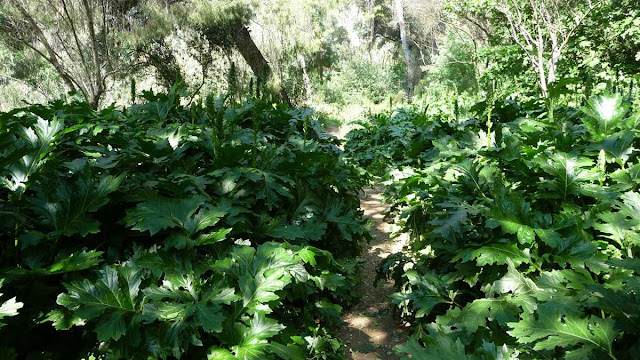A very Greek species, Acanthus spinosus.
Acanthus is a genus of about 30 species, most of which are found in the Mediterranean Basin and Asia. The name Acanthus is the latinized Greek word for thorn and thistle (άκανθα - acantha). In Greece one can find three species, A. spinosus, A. balcanicus and A. mollis. The first two are native.
Acanthus spinosus is a spiny herbaceous perennial plant widespread in Greece, that is also found in parts of southern Italy and Albania. This very Greek and very architectural plant is found both in dry lowland and open woodland in higher elevations, and on many islands. It produces many large, dark green, glossy leathery leaves, that are often very flat, finely cut and beautifully veined, and that dry out each summer. Even more distinctive are the tall erect flower spikes with the unusually structured white flowers and the hard shelled, spiny reddish bracts.
Acanthus balcanicus is a herbaceous perennial plant of the Balkan Peninsula, with beautiful long lobed leaves that bear no spines, and with very similar flower spikes to those of A. spinosus. I haven't come across this plant yet.
Acanthus mollis is another herbaceous perennial plant with an underground rhizome, that forms clusters of very large, shiny handsome dark-green leaves, quite similar to those of A. balcanicus. The flower spikes are very similar to those of A. spinosus, and often much taller. The name "mollis" means soft, suggesting the non-spiny elegance of its leaves. Although this plant is native to the Mediterranean region it is not recorded as a species native to Greece, which is most probable. I haven't met this plant in the wild either.
All three species, A. spinosus, A. balcanicus and A. mollis, are widely grown as ornamental plants, A. mollis being considered as one of the earliest cultivated species. Maybe the tougher and more humble A. spinosus would make a more appropriate choice for archaeological sites vegetation, than the usually selected A. mollis.
__________________________________________________________________
Το γένος Acanthus περιλαμβάνει 30 περίπου είδη φυτών, τα περισσότερα από τα οποία απαντώνται στη Μεσόγειο και στην Ασία. Στην Ελλάδα μπορεί να συναντήσει κανείς τρία είδη, A. spinosus, A. balcanicus και A. mollis, εκ των οποίων τα δύο πρώτα είναι αυτοφυή.
Η Άκανθα, Acanthus spinosus, είναι ένα πολυετές ακανθώδες φυτό που είναι διαδεδομένο στην Ελλάδα και σε κάποιες περιοχές της Ν. Ιταλίας και της Αλβανίας. Αυτό το πολύ ελληνικό και πολύ αρχιτεκτονικό φυτό φυτρώνει τόσο σε ξηρά εδάφη κοντά στη θάλασσα όσο και σε ξέφωτα δασών και λιβάδια σε μεγαλύτερα υψόμετρα, καθώς και σε αρκετά νησιά. Τα φύλλα του, που κάθε καλοκαίρι ξεραίνονται, είναι μεγάλα, γυαλιστερά σκουροπράσινα, με μια αίσθηση σκληρού δέρματος, και πολύ συχνά είναι επίπεδα, τέλεια διαχωρισμένα και με όμορφες γραμμώσεις. Πολύ χαρακτηριστικός είναι και ο ψηλός ανθοφόρος βλαστός με τα ασυνήθιστα δομημένα λευκά λουλούδια και τα σκληρά, ακανθώδη κοκκινωπά βράχτια.
Το είδος Acanthus balcanicus είναι μία πολυετής Άκανθα των Βαλκανίων, με όμορφα επιμήκη διαχωρισμένα φύλλα χωρίς αγκάθια, και με ανθοφόρους βλαστούς πολύ όμοιους με εκείνους του A. spinosus. Ακόμη δεν έχω συναντήσει αυτό το είδος.
Το είδος Acanthus mollis είναι ένα ακόμη πολυετές ποώδες φυτό με υπόγειο ρίζωμα, το οποίο σχηματίζει συμπλέγματα από πολύ μεγάλα, γυαλιστερά εντυπωσιακά σκουροπράσινα φύλλα, πολύ όμοια με εκείνα του A. balcanicus. Τα λουλούδια του είναι και αυτά όμοια με του A. spinosus, και συνήθως πολύ ψηλότερα. Το όνομα "mollis" σημαίνει απαλός, υπονοώντας την χωρίς αγκάθια παρουσία των γοητευτικών του φύλλων. Παρό το γεγονός ότι αποτελεί ένα χαρακτηριστικό μεσογειακό είδος, δεν καταγράφεται ως αυτοφυές στην Ελλάδα. Ούτε και αυτό το είδος έχω συναντήσει στην ύπαιθρο.
Και τα τρία είδη, A. spinosus, A. balcanicus και A. mollis, καλλιεργούνται ευρέως ως καλλωπιστικά φυτά, ενώ το A. mollis θεωρείται ως ένα από τα αρχαιότερα καλλιεργημένα φυτά. Ωστόσο, το πιο σκληρό και ταπεινό A. spinosus θα άρμοζε καλύτερα ίσως ως καλλωπιστικό φυτό στους αρχαιολογικούς χώρους απ΄ ότι το δημοφιλέστερο A. mollis.
The following images are of Acanthus mollis.
























I have used one of your images on my blogger site, leavingmynormal.blogspot.fr and have given you credit for it. Lovely blog here. I am a very keen plant person
ReplyDeleteyou are very welcome!! :)
ReplyDelete